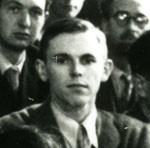
At Caltech, David immediately demonstrated a remarkable ability to work imaginatively, with seemingly automatic supreme organization and with great effect on any problem he was given, first in the context of wartime research and later in crystallography. His thesis (I. An Attempt to Prepare Antibodies to Histamine In Vitro, II. An Investigation of a Possible Method for Preparing Large Single Crystals of Aluminum Orthophosphate, III. A. An Investigation of the Space-Group and Lattice Constants of DL-Serine, B. An Investigation of the Crystal Structure of L-Threonine) records two investigations he made during the war, one for Carl Niemann and one for Pauling, but he worked on other war projects also.

David P. Shoemaker, 1947.
Extracted from a group photo of participants at the Conference on Current Problems of Physics. Copenhagen, Denmark.
An article on the design and use of a special viscometer [D.P. Shoemaker, Earl Hoerger, R.M. Noyes and R.H. Blaker (1947). Anal. Chem. 19, 131] was one product of his work on Pauling and Corey's big study of the 'stability of double-base propellants'. Another was the electron-diffraction determinations he made of the structures of 16 molecules, which appeared in a compilation [P. W. Allen and L.E. Sutton (1949). Acta Cryst. 3, 46-72; VS is now astonished to find them attributed to B. Schomaker, as privately communicated by L. Pauling and V. Schomaker].
The threonine study was notable for other reasons also, but we want to dwell on how David in his visual estimation of the intensities systematically compared all the reflections seen on complete sets of multiple-film Weissenbergs for all three orthorhombic axes. He also gave estimates of the errors to be feared. These correspond to a standard deviation of about 8.5% in an intensity measurement or perhaps 4.3% for an |F|, hardly in agreement with the 11.2% R value reported [D. P. Shoemaker, J. Donohue, V. Schomaker and R. B. Corey (1950). J. Am. Chem. Soc. 72, 2328-2349] for the determination, which concluded with a single cycle of full-matrix refinement, with fixed scale factor and fixed equal isotropic B's for all the atoms, that required about 100 h of IBM 602 time.
More recently, full-matrix least-squares refinement of the structure with Hughes weights, isotropic freely adjusted H atoms and anisotropic C, N and O atoms has led after many cycles (and a few minutes of computer time) to R = 4.4%. It seems that David's visual intensity estimates for threonine, 49 years ago, were as good as he said they were, and that the authors SDSC simply failed to account for them because their computing methods and model were far from adequate.

